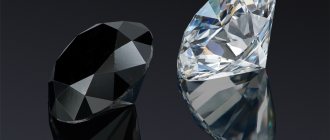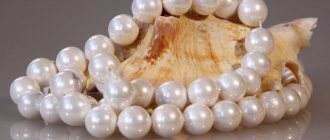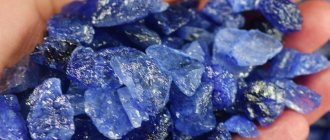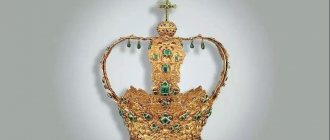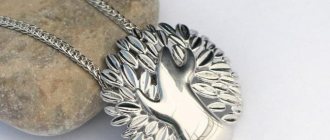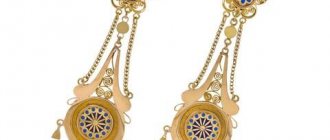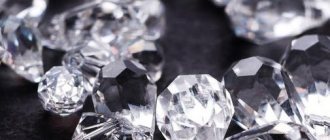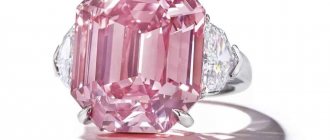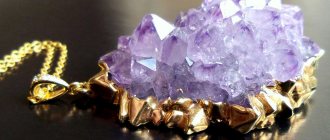Jewelery is like the perfect spice – it always complements what is already there.
Jewelry is like the perfect spice - it always complements what you already have.
Remember how in the famous fairy tale Ali Baba found a cave with treasures? The robbers hid rings, earrings, bracelets, necklaces, tiaras, a lot of gold and silver in it. And we all loved the exciting stories about how pirates hid their treasure in chests and buried their treasure on uninhabited islands: pendants, gemstones, diamonds, broaches and cameos. And now we just need to leave the house and look into the nearest jewelry store (jeweller's) to get into the world of jewelry. This is where sophisticated (exquisite), glamorous (glamorous), attractive (glitzy) jewelry for all occasions (wear-anywhere) is stored.
Jewelry in English
If you have not yet decided what jewelry to order for the holidays, then remember the word jewelry
.
This means “jewelry, jewelry.” By the way, all this is sold in the jewelry store
(jewelry store).
Perhaps you dream of receiving only one piece of jewelry as a gift. Then feel free to ask Santa Claus for a piece of jewelry
.
Well, if your personal Santa Claus loves slang words, and you adore flashy jewelry, then don’t hesitate to use the word bling-bling
.
By the way, other synonyms for the word jewelry can be the words gems
and
jewels
.
Well, all sorts of inexpensive trinkets and trinkets, dear to every woman’s heart, are called bauble
.
Earrings in English
Of course, in the modern world there are a lot of names for all types of earrings. But we will pay attention only to the most important names of earrings in English, which will help you somehow orient yourself in the abundance of a jewelry store.
- The simplest earrings that many are familiar with from childhood are huggie/huggy earrings
. As we understand from the name, these are earrings that seem to “hug” the earlobe and prevent this piece of jewelry from being lost so easily. - Many piercing enthusiasts are familiar with stud earrings. In English it would be stud earrings
. It is interesting that in both Russian and English this word is based on the word “nail” (stud - a nail with a large head, a button). - If you love dangle earrings, then know the English words drop earrings
and
dangle earrings
. But usually drop earrings mean that the earring weighs one or two small stones. And when we talk about dangle earrings, there can be a lot of things that dangle (swing, hang down). Even native speakers themselves do not always know the difference between these two types of earrings. - Do you like hoop earrings? These are called hoop earrings
. Hoop – hoop, rim, ring. - Want something elegant? Try earrings with a long chain. You just need to carefully pull the chain through the ear hole and adjust the length of the jewelry. This piece of jewelry is called ear thread
(thread – thread, fiber). - Do you like something original? Take a closer look at slave earrings
. They are also called
Bajoran earring
. This type of jewelry has a small ring that clings to the ear. The name slave earrings (slave) can be seen from there.
Rings in English
The rings themselves will be called rings
.
But, of course, there are different types of this jewelry. The most important ring that almost every girl thinks about sooner or later is the wedding ring
.
Before it, you can sometimes get an engagement
. Nowadays, it is fashionable to wear both of these jewelry at once abroad. First, an engagement ring is put on the ring finger, and then a wedding ring. So it is worth choosing these rings with a similar design.
A man's signet ring will be called a signet ring
.
Sometimes rings with stones are named according to the engraving of the stone. So don’t be surprised if you hear names of rings in English such as cushion ring or pear ring. This simply means that the main stone on the ring is cut into a “cushion” or “pear” shape.
By the way, if you are interested in what fingers are called in English, then be sure to read our article on this topic.
Some beautiful words and phrases
Sometimes beautiful English words with translation into Russian are needed in a specific language situation - for example, when you want to gracefully speak about your love or someone’s beauty, while expressing the highest feelings. For such cases, it is worth taking note of a few English words in advance.
Beauty is in everything
About love
Over the millennia of human civilization, an infinite amount has been said about love - and it is this feeling that has given us a huge number of beautiful expressions. Beautiful words about love in English are another way to express your emotional experiences orally or in writing:
- adoration - adoration;
- infatuation - reckless passion, blind infatuation, passionate love;
- desire – desire;
- passion - passion;
- bliss – bliss;
- to fall for smb – to fall in love with someone;
- limerence – romantic love;
- obsession - obsession;
- to be head over heels in love - to be in love without memory.
To tell a girl
With special care, we select compliments for girls - beautiful and often deeply caring. You can try to win over a person who speaks English with a few beautiful words to a girl in English:
- fabulous - incredible;
- talented - talented;
- gifted – gifted;
- inspirational - inspiring;
- cute - sweetheart;
- nice – good, kind;
- sunshine – sunlight, sun;
- perfection - perfection;
- beauty – beauty, beauty;
- intelligent - smart;
- bright – bright.
Chain in English
The chain itself in English will be chain
. But, unfortunately, everything is not so simple here. As we know, there are different types of chain weaving. It’s easier to see once than to hear a hundred times. So pay attention to the pictures, where each weaving known to us is given a corresponding name in English.
a pendant on your favorite chain
(pendant, pendant),
medallion
(medallion) or
locket
(opening medallion where a photo of a loved one is stored).
If you often go out, then you definitely have a necklace or necklace. In English it will be necklace
(neck – neck, lace – lace).
And your favorite string of pearls is called pearl necklace
.
Well, if you like something simpler and respect good old beads, then the word beads
(or bead-necklace).
What minerals are considered precious?
In human history, gemstones are considered a symbol of wealth, power and high position in society. There are about 4,000 minerals in nature, a little more than 100 of them are raw materials for precious stones. A person’s idea of the nature of minerals is changing, and the characteristics of precious stones are replenished with new properties and qualities.
What requirements do modern gemologists and jewelers place on precious stones? To determine the value of a particular sample, it is checked according to the following criteria:
- Beauty . Not only the original appearance of the gem is taken into account, but also how it will look after processing. This characteristic includes several parameters: color, transparency, pattern, degree of light refraction, gloss, optical effects and polishability.
- Persistence . It is determined by the physical characteristics of precious minerals, chemical composition and crystal structure. This parameter includes hardness, density, color stability and transparency, resistance to environmental influences and mechanical damage.
- Rarity . Many stones lost their precious status after the discovery of new rich deposits. Depletion of reserves also has an effect, in this case the mineral increases in price.
- Naturalness . Natural stones with natural colors will always have more exclusivity for humans than their imitation.
- Compactness . The shape and size of the gem must be suitable for further processing and use.
Bracelets in English
Recently, probably thanks to the appearance of Pandora bracelets, Russian-speaking people are not surprised by the word “charm”. English word charm
means not only charm and charisma, but also an amulet, keychain.
The bracelets themselves in English will be bracelet
.
If your bracelet is made of hard material and holds its shape well, then it is already a bangle
.
You can also wear a watch
(watch) or
wristband
(wrist bandage).
If you were fond of making bracelets from beads as a child, then know that such jewelry is called beaded bracelet
.
Of course, jewelry comes from different materials. Some people only love precious metals
):
gold
(gold),
silver
(silver),
platinum
(platinum). And some will be happy with any decoration, as long as they like the design.
We hope that our article with English vocabulary on the topic “Jewelry” lifted the curtain on the world of fashion and gave you some ideas on what to please your loved ones for the New Year, or, conversely, what to ask Santa Claus for.
Shutikova Anna
Category: English for life
A B C D E F G H I J K L M N O P R S T U V
SABALITE is a green variscite from Utah, USA, with distinct light and dark stripes. SABOIT is an outdated name for hypersthene. SAGENITE - microscopic needle-like growths of rutile in other minerals, for example, in quartz, ruby, biotite, etc. These growths are located at an angle of 60°, forming a network, due to which iridescence appears on the surface of the stone. SALIT - monoclinic pyroxene, close to diopside with a high Fe content, dark green color, reminiscent of malaconite. SAMARSKITE is a mineral of the (Y,Er)(Nb,Ta)2O6 oxide class. SAMFIRE is an obsolete name for sapphire. SAMOITE is an obsolete name for Labradorite. RAINBOW GEM – slightly opalizing synthetic rutile. SANGUINE – hematite. SANGIESHAN is a dark green bowenite from northwestern China. SANGO is a high quality red coral. SANGUINITE is a dark red mineral with a chemical composition close to proustite. Extracted in Chile. SANDARES is the ancient name for a red-brown variety of quartz with numerous inclusions of hematite or opal matrix (aventurine), giving a characteristic shimmer. SANDASTROS is a red-brown aventurine containing numerous inclusions of mica resembling particles of gold. An ancient name, but sometimes found in specialized literature. SANIDINE is a mineral, a high-temperature variety of potassium feldspar. SANTA MARIA – top quality aquamarine; trade name, often used in Brazil. SANFIRE is an obsolete name for sapphire. SAPPAR - sapparite. SAPPARITE - blue kyanite from Banffshire (Scotland), local name. SAPPARE – kyanite, trade name in France. SAPPHIRE is a transparent variety of corundums of blue, cyan, violet, golden yellow, yellow-green, pink colors. AUSTRALIAN SAPPHIRE – dark blue sapphire with a milky-white, cloudy sheen, as well as greenish sapphire with light and dark stripes. ALEXANDRITE SAPPHIRE – synthetic corundum with the effect of alexandrite (green in daylight, wine red in artificial light). ALMANDINE SAPPHIRE is a natural sapphire of red-violet color, reminiscent of almandine in color. AMETHYST SAPPHIRE – synthetic corundum of amethyst color. ANAKA SAPPHIRE – yellow Australian sapphire from the vicinity of Anaka (Queensland), geographical name. WHITE SAPPHIRE – leucosapphire. COLORLESS SAPPHIRE – leucosapphire. BURMAN SAPPHIRE – greenish-blue sapphire. BRAZILIAN SAPPHIRE – blue topaz or blue tourmaline (indigolite), a misnomer. WATER SAPPHIRE is a light blue sapphire, also a misnomer for cordierite or pale blue topaz from Sri Lanka. GEUDA SAPPHIRE is a common name for sapphires mottled with milky white or yellow spots, and also a misnomer for yellowish-green spinel with thermally altered color. SAPPHIRE JIRAZOL – cat's sapphire, sapphire cat's eye. SAPPHIRE GIRAZOLE – sapphire cat's eye. STAR SAPPHIRE is an opaque variety of blue corundum with an asterism effect. GOLDEN SAPPHIRE – lapis lazuli with numerous golden-yellow pyrite growths, a misnomer. KASHMIR SAPPHIRE is a dark blue sapphire from Kashmir (India) with a milky-white, cloudy hue, which is explained by thin, milky-white inclusions located at an angle of 120 degrees relative to each other. FALSE SAPPHIRE – blue fluorite or cordierite. SAPPHIRE LUX is a misnomer for cordierite. SAPPHIRE LUXURY TOKAJ – obsidian from the Tokaj Mountain (Hungary), incorrect name. SAPPHIRMERU - blue zoisite (tanzanite) from Mount Meru in Tanzania, a misnomer. MONTANA SAPPHIRE – light blue American sapphires in which the stages of crystal growth are marked by inclusions of rutile “dust”. SAPPHIRE SCIENTIFIC is the general name for blue imitation sapphire, usually blue glass. SHOWING SAPPHIRE – cat sapphire. PADMARAJA SAPPHIRE is an orange (reddish-yellow) sapphire. PADPARADJAH SAPPHIRE is a natural or synthetic orange sapphire. PAILIN SAPPHIRE – Cambodian sapphires from light to dark blue, polysynthetic plate doubles. HEATED SAPPHIRE – sapphire (as well as ruby) subjected to heat treatment in order to obtain a spectacular blue or deep blue color. SAPPHIRE PURPLE – amethyst-colored corundum. PINK SAPPHIRE – pink-red corundum. LYNX SAPPHIRE is a misnomer for cordierite and is also a rarely used name for dark sapphires. SIAMESE SAPPHIRE – natural Thai sapphire of cornflower blue color. TANZANIAN SAPPHIRE is a sapphire from the Umba River Valley (Tanzania), and also a misnomer for tanzanite. TOPAZ SAPPHIRE – yellowish to yellowish corundum, a misnomer. URAL SAPPHIRE – yellowish to yellowish corundum, incorrect name. CEYLON SAPPHIRE – pale blue spotted Sri Lankan sapphire. ZOISITE SAPPHIRE - blue zoisite from Tanzania, a misnomer. SPINEL SAPPHIRE is a misnomer for blue spinel. SAPPHIRE – blue chalcedony. SAPPHIRE QUARTZ - coarse-grained accumulations of quartz with numerous dark blue intergrowths of fibrous cordierite or needle-shaped intergrowths of dumortierite or indigolite, also called blue chalcedony. SAPPHIROS is an ancient name for blue minerals of the sodalite group, mainly lapis lazuli. SAPPHIRE-SPAR is the old name for kyanite. SARGAT – sardine agate. SARD is a translucent variety of chalcedony from yellowish-brown to brownish-red color. SARDA - the ancient name of Sard according to Pliny and Theophrastus. SARDEGENA is the trade name for dark red corals from the Mediterranean Sea. SARDER – the same as sard. SARDINIAN is an anglesite mined on the island of Sardinia. SARDIUM – translucent chalcedony from pinkish to brown. SARDIUS is the ancient name of brown carnelian (carnelian) according to Agricola, as well as the ancient and medieval name of sard according to Pliny, Marbod, Bartolomeo, Albertus Magnus and others. SARDOINE is a dark red carnelian, as well as artificially colored sard. SARDONIC – sardonyx. SARDONYX is an onyx consisting of alternating white and brown-red layers. SARDUIN – blue chalcedony. SARCOPHAGUS is the ancient name for a stone (marble or alabaster) used for making sarcophagi. SATELITE is a fibrous variety of serpentine from grayish to greenish-blue color, which, when cut appropriately, can give a cat's eye effect. SATIN SPAR – satin spar. SAFIRE is an outdated name for sapphire. SAFIRAS – light blue Brazilian topaz. SAFIRINE - blue chalcedony (sapphirine), and also a misnomer for a translucent variety of blue spinel. SAFIRINA – spinel or blue quartz, a polysemantic term. SAFRANITE is a heated citrine-colored amethyst, as well as citrine. SAFFRONITE – safranite. SAKHALINITE – Sakhalin amber, has a thick brown-cherry color. LEAD SHINE – galena. LEAD EARTH is an earthy variety of cerussite. LEAD MICAS – thin-plate crystals of cerussite. SEBESIT is an outdated name for tremolite. CEDARITE is a type of amber from Manitoba (Canada). SELENITE is a fibrous gypsum with a silky sheen of white, soft pink, or orangeish color. SELENITE URAL - selenite. SELLAITE is a mineral, magnesium fluoride MgF2, isomorphic with rutile. SELVINITE is a muscovite rock close to verdite with a significant admixture of fuchsite and diaspore or chlorite. Mined in the Heathcote area, Victoria, Australia. FAMILY is an outdated name for freshwater pearls weighing up to 0.25 grains. SENARMONTITE is a mineral, antimony oxide Sb2O3, isomorphic with valentinite. SEPIOLITE – (meerschaum) mineral of the class of layered silicates, hydrated magnesium silicate. NATIVE SULFUR is a chemical element, a mineral, which, depending on conditions, can form six different crystalline modifications. SERANDITE is a mineral from the wollastanite group. SERAPHINITE – clinochlore, a mineral from the chlorite group. CARNELIK is a variety of chalcedony that is pink, red and yellow in color. SILVER STONE is the traditional French name for moonstone. SULFUR PYRITE – pyrite. SERPENTINE - also known as serpentine, a group of minerals of the class of layered silicates and aluminosilicates. Usually, two minerals of the serpentine group are distinguished: antigorite and chrysolite, and among them are colored varieties: baltimoreite, bowenite, williamsite, satellite, ricolite, picrolite, pseudophyte, officite, marmolite, etc. SERPENTINE-ASBESTOS - serpentine asbestos. NOBLE SERPENTINE is a translucent dense variety of serpentine of uniform green, olive green or yellowish color. SERPENTINITE – (serpentine) rock consisting of serpentine group minerals (antigorite, chrysotile and lizardite, bastite, serpophyte), as well as chlorite, talc, chromite, magnetite and olivine relics. SERPOFITE – noble serpentine, the same as ophite. SERRA STONE is a trade name for etched banded chalcedony. SERRA TOPAZ is a trade name for citrine or burnt amethyst from Serra do Mar, Brazil. SERRASPITZEN - rhombohedral crystals of amethyst with dark purple coloration of the crystal tips, found in druses in the vicinity of Serra do Mar, Brazil. SIBERITE - also known as sibirite, an opaque variety of elbaite (a mineral of the tourmaline group) of red (pink, violet-red, mauve) color, discovered near Nerchinsk, Buryatia, Russia. (Violet-red and mauve colors can be viewed in Yandex by copying RGB 199-21-133 and RGB 153-51-102 into the search, respectively). SIBIRITE - siberite. SIDErite is a mineral, anhydrous iron carbonate FeCO3. SIDYEN – black jasper. SILEKS – jasper with yellow and red layers. SILICIOPHYTE – opalized serpentine. SILICITE – labradorite, as well as siliceous rock of various composition and origin. SILLIMANITE is a mineral of the group of island silicates, isomorphic with andalusite and disthene. SILLIMANITE-JAD – false jade, dense, brown or greenish sillimanite, externally resembling jade. SIMAV-OPAL - fire opal from the valley of the Simav River near Mount Safan, Turkey. SIMAN is an imitation diamond, usually strontium titanate or a doublet made of synthetic corundum and strontium titanate. SIMERALD – synthetic emerald. SIMETITE is a red-brown fossil resin (amber) from the sands of the Simeto River near Catania, Sicily (Italy). This amber exhibits blue fluorescence. SIMILIBRILLIANT - diamond-cut rock crystal or glass that imitates a diamond. SIMILIDIAMANT - an imitation of diamond, usually rock crystal or other colorless imitation with an admixture of thallium, which increases the refractive index. SIMAVSTEIN – simav-opal. SIMPSONITE is a mineral of the oxide class. Composition: AlTaO4 with admixtures of Nb, Sn and Ca oxides. SINGALITE is a mineral of the island borate group. The composition is MgAlBO4 with Fe impurities. BLUE JOHN is a variety of fluorite, see Derbyshire Blue John. BLUE IRON EARTH – Vivianite. SINOPAL – red aventurine quartz (aventurine). SYNTHELITE - synthetic corundum, which changes color depending on the type of lighting, is used to imitate alexandrite. SINHALITE is a synthetic corundum that changes color when the lighting changes. SIRIAM is an almandine from the vicinity of Siriam, the ancient capital of the Pegu kingdom in Burma (Myanmar). SYRIAN GARNET is a high quality purple almandine. SYRITES is the ancient and medieval name of the “star-shaped” variety of sapphiros, mentioned by Pliny and other stone researchers (Marbod, Bartolomeo, Albertus Magnus). SIOUX FALLS JASPER - brown and yellow jasper from Sioux Falls, South Dakota, USA. SCAPOLITE is a series of minerals of the group of isomorphic framework silicates of Na and Ca. The extreme members of the series are marialite and meionite. SKARN is a rock composed of alternating strips of different minerals, the most common of which are quartz, calcite, wollastonite, hedenbergite, datolite, garnet and epidote. SKATEN – sloping pearls. SQUARES is the popular name for quartz. SCYTHIAN SMARAGD - see smaragd, smaragdus; Probably, the Scythian emeralds mentioned by Pliny the Elder are of Ural origin. SCOLECITE is a mineral of the zeolite group. Forms a continuous isomorphic series together with natrolite and mesolithic. SKORODIN - skorodite. SCORODITE is a mineral of the class of hydrated arsenates, a rare jewelry stone of apple green, greenish white, bluish green or brownish gray color. SCORZALITE is a mineral of the anhydrous phosphate class, forms a continuous isomorphic series with lapis lazuli. SKUTTERUDITE is a mineral of the arsenide group, isomorphic to smaltine. APACHE TEARS are small, pebble-like obsidian grains with a colorless core that occur in partially weathered obsidian. SLOKUMA STONE – glass imitating precious opals. IRON MICAS – hematite. LEAD MICAS – thin-plate crystals of cerussite. SMAGARD – emerald. SMALTINE is a mineral of the arsenide group, isomorphic to skutterudite. SMARAGD is an outdated name for emerald. SMARAGDITE is an emerald green, lamellar variety of pyroxene (diallag), partially or completely replaced by hornblende (actinolite). SMARAGDOLIN – green beryl glass imitating emerald or other ornamental stones. SMARAGDUS is the primary Latin name for emerald. SMARILL – a doublet of two colorless beryls glued together with emerald-colored cement. IRON SOUR CREAM – hematite. SMIRGEL – corundum. SMITHSONITE is a mineral of the class of anhydrous carbonates ZnCO3. SMOLYAK is the name of morion in the Urals. COLLECTED – pyroxmangite. OWL'S EYE is the English name for an agate with a pattern of double concentrates in which the distribution of colors resembles an owl's eye. Same as eye agate. SOGDIANERIN – imitation opal using liquid crystals. SOGDIANITE is a mineral of the silicate class. SODALITE is a mineral of the subclass of aluminosilicates with a framework structure. SOYMONITE – corundum. HAWKEYE - translucent quartz with a silky green, bluish-blue tint and an optical effect in which a stripe appears, reminiscent of the pupil of a hawk's eye. Occurs when light rays scatter on inclusions of blue crocidolite fibers. SUN TOURMALINE – columnar aggregates of tourmaline with a concentric-radial structure. SOMANSITE is a type of vardite, very similar to amblygonite. SOMONDOCO is the old name for emeralds from the Chivor mine (Colombia). SORELLA is a synthetic strontium titanate manufactured as a diamond imitation. SAUSSURITE is a mineral, a product of alteration of plagioclase rich in anorthite, containing epidote, zoisite, albite, small amounts of sericite and calcite. SPALMANDITE is a garnet of intermediate composition between spessartine and almandine. SPARALITE – zincite, old name. SPARKLITE – colorless zircon. SPARTALITE – zincite, old name. BRAZED EMERALD – a doublet made of quartz and low quality emerald. SPECTROLITE – labradorite from Lammenpää (Finland). SPECULARIS is an ancient and early medieval name for stones (minerals) that can be split into thin, shiny plates and then used as window glass. In the Middle Ages, according to the description of Albertus Magnus, clear as glass (muscovite), black (biotite) and yellow (orpiment) varieties were distinguished. SPECULARITE is a coarse-crystalline variety of hematite. SPESSARDINE - garnets with a chemical composition intermediate between spessartine and almandine. SPESSARTINE is a group of garnets that are yellowish, orange-red, brownish-red and brownish-black in color. SPESSARTITE – spessartine. DOVE'S BACK – matrix turquoise, variscite, chlorastrolite, ambiguous term. SPIONSKOPITE is an intermediate mineral in the Cu-S solid solution system of composition Cu1.4S, see chalcocite. SPODUMENE is a mineral of the pyroxene group, a chain silicate of aluminum and lithium. SPODUMENE NOBLE – colorless or light yellow spodumene. SPODUMENE-AMETHYST – kunzite, a misnomer. SPODUMENE-EMERALD – giddenite, incorrect name. SPURRIT is a mineral of the island silicate group, used as a jewelry stone. STAUROLITE is a gray, red-brown, dark brown to black mineral, hydrated aluminum silicate. BERYL GLASS is a glass mass obtained from fused low-quality beryl. DARWIN GLASS – natural glass of meteorite origin of various colors. GIRL'S GLASS – Maria's glass. FEMALE GLASS is an old humorous name for gypsum. QUARRY GLASS – natural brown and green glass found in the gold sands of Sri Lanka. Reminds me of moldavite. CRATER GLASS is a natural glass formed by the fusion of quartz sand as a result of a meteorite impact. LIBYAN GLASS is a very pure volcanic glass found in the western part of Libya. Contains 98% silica. MARIA'S GLASS – transparent plaster. METEORITE GLASS – crater glass. MULLER GLASS is a colorless, transparent variety of hyalite that resembles molten glass. RUSSIAN GLASS - muscovite, the old name, dates back to the time when muscovite plates were inserted into windows. SELENIUM GLASS – occurs as a result of underground fires, found in Arizona (USA). CRYSTAL GLASS – lead glass, an artificial product. Glass red head - hematite. Stellarit is a blue quartz with an admixture of chrysolla and other copper minerals. Stybiotantalite - a mineral of a class of oxides, niobat and tantaloli antimony. Settings - a mineral of a class of hydrated carbonates. Styishovit is a variety of quartz. Rhuba - a glass imitation of a diamond or other precious stone. Rhuba-Almaz -the trade name of rock crystal or a glass imitation of diamond. Amur arrows - quartz with numerous hair -shaped inclusions Rulel. The arrows of love are the arrows of the Amur. Lightning arrows are the folk name of the Fulgurites - the rods of silicate glass formed during the melting of quartz sand when the lightning struck. Strulings - a blue zircon. Strongit - synthetic spinel. Stronzinin - a mineral of the Aragonite group (anhydrous carbonate). Strnstani-Calcite -stringsite containing calcite (up to 13%) in the form of an impurity. Striever - ruttered with an admixture of niobium and tantalus. Sugilite - a mineral of a group of ring silicate. Succinggranate is an amber-yellow Grossular, the wrong name. Succinite is a variety of amber, as well as amber-yellow Grossular. Succinus is the antique name of amber. Sumansitis is the local name of Vardita from the Sumansa deposit to Montebra (France). Sunwanwell is an obsolete name for heliotrope. Sufsi -greenish-blue lapisit the third grade. Sephalaris - mineral, zinc sulfide. Spen - titanite. Spherical - spheroidal units of variscyta or pitch. Sierra Topaz -Serra-Kamen. Sierra-Stein -Serra Topaz.
Comments
| Sergey Krasnov If you understand that your need is charitable assistance, then pay attention to this article. Those who, without your participation, may lose an exciting business have turned to you for help. Many children, boys and girls, dream of becoming pilots on the track. They attend classes where, under the guidance of an experienced trainer, they learn high-speed driving techniques. Only constant exercises allow you to overtake correctly, build a trajectory and choose speed. Winning on the track is based on good qualification. And, of course, a professional kart. Children who participate in clubs are completely dependent on adults, because lack of money and broken spare parts do not allow them to participate in competitions. How much pleasure and new sensations children experience when they get behind the wheel and start driving the car. Maybe it is in such a circle that not only Russian champions grow up, but even future world champions in this sport?! You can help the children's karting section, which is located in the city of Syzran. They are in a really bad situation right now. Everything rests on the enthusiasm of the leader: Sergei Krasnov. Read my letter and look at the photos. Pay attention to the passion with which my students work. They love this developmental sport and really want to continue learning. I am asking you to help the karting section in the city of Syzran survive. Previously, there were TWO young technician stations in the city, and each had a karting section. There was also karting at the Palace of Pioneers. Now there is not a single station in the city, and the circle in the Palace of Pioneers was also destroyed. They closed it, I can’t say enough, they just destroyed it! We fought, wrote letters, and everywhere they had the same answer. About five years ago I went to the governor of the Samara region for a reception. He didn’t accept me, but my deputy accepted me. After that, we were given premises where we were based. We have a lot of children who want to go karting, but very poor material conditions do not allow us to recruit children. And most of the karts require repairs. This is the situation our circle is in. We also turned to the mayor of the city of Syzran for help. This is the second year we have been waiting for help. We decided to turn to you via the Internet for help. Contact me, address for PACKAGES, 446012 Samara region, Syzran, Novosibirskaya street 47, you can contact me through social networks SERGEY IVANOVICH KRASNOV. or write to the mail Always, being on the wave of success, you need to do works of mercy, give alms. And if the Lord helps in difficult circumstances, then do not forget about gratitude afterwards. Then He will not forget about your needs. |
| Sergey Krasnov The topic of karting is still relevant, write if you want to help. And we also have a petition, if you don’t mind signing it. https://chng.it/cPmmdqsk |
| Sergey Krasnov Contact me, ADDRESS FOR PACKAGES, 446012 Samara region, Syzran, Novosibirskaya str. 47, PACKAGES CAN BE SENT BY TRANSPORT COMPANIES THAT ARE IN THE CITY, help can be provided, transferred by phone number 89276105497, you can contact via social networks SERGEY IVANOVICH KRASNOV .or write to [email protected] And we also have a petition, if you don’t mind signing it. https://chng.it/cPmmdqsk Always, being on the wave of success, you need to do works of mercy, give alms. And if the Lord helps in difficult circumstances, then do not forget about gratitude afterwards. Then He will not forget about your needs. The karting topic is still relevant, write if you want to help. |
In a jewelry store
By the way, the word jewelery has two spellings: jewelry (American English) and jewelery (British English). You can choose any spelling, the main thing is to determine one option for yourself and stick to it.
You can learn how to choose the right jewelry and consult with the seller by watching the following video:
List of useful phrases from the video
- Necklace – necklace, choker.
- What do you recommend? - What do you recommend?
- Flower pendant – a pendant in the shape of a flower.
- Sophisticated - sophisticated.
- It looks a little long. - It's a little long.
- That's too expensive. - It's too expensive.
- I'll take... - I'll take...
- How much is this over here? – How much does this (this) cost?
- I'm looking for... - I'm looking for...
- Pearl necklace - pearl necklace.
- Sure thing. - Of course, of course.
These are the phrases you might hear from a salesperson in a jewelry store:
| Phrase | Translation |
| Can I help you with anything? | May I help you? |
| Let me get it out for you. | Let me get it (the product) for you. |
| What size do you need? | What size do you need? |
| I'll check the price for you. | I will confirm the price for you. |
| Why don't you try this one on? | Why don't you try this on? |
| Actually, we have a few to choose from. | We actually have several (products) to choose from. |
Useful phrases for a buyer in a jewelry store:
| Phrase | Translation |
| Can I look at this ring? | Can I have a look at this ring? |
| I believe I have sixth. | I believe my (ring) size is a size six. |
| Do you have any necklace that would go well with this? | Do you have a necklace that will match this (item)? |
| There's no price tag on this necklace. | There is no price tag on this necklace. |
| This necklace is a little short. | This necklace is a little short. |
| This one is much better. | This (product) is much better. |
| Can I try on the ring with this necklace? | Can I try on a ring with this necklace? |
